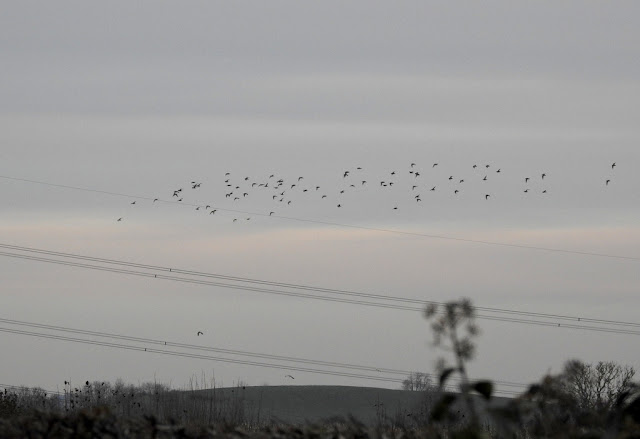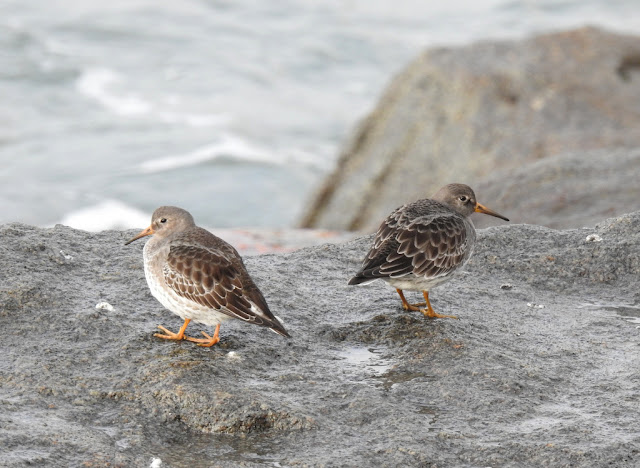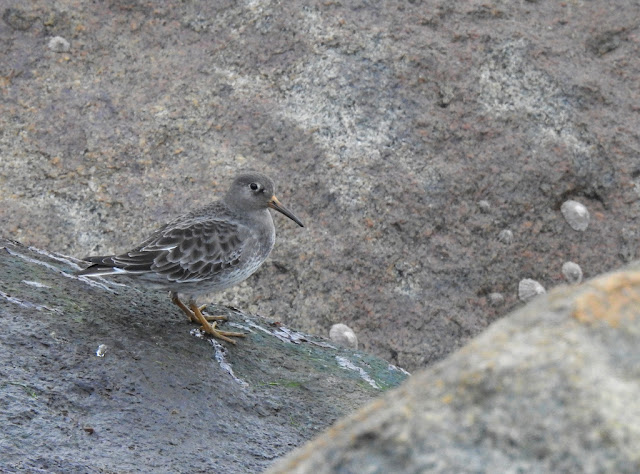The first round of Bridport Bird Club's House Sparrow survey is now complete. Each of my last two counts produced a nice bonus bird...

|
|
A lovely Firecrest in Symondsbury churchyard. What do you mean,
'Where is it?'?! |
 |
| A/the Goosander on the River Asker just a few minutes from home last Saturday. |
We're back on the sparrows from January 8th, and I've no doubt there will be some more surprise encounters with birds which aren't sparrows. One of the major highlights this time around was Luke's trio of Dartford Warblers. I went for another look on Saturday morning, and found two of them. Both were rather shy, but one looked suspiciously like an adult male, which I certainly didn't see last time. Some other birds in the same area...
 |
| Lesser Redpoll. An uncommon winter bird locally. |
 |
| Reed Bunting. One of 25-30 at least. Perfect Little Bunting bait. One can always hope. |
 |
| Only a Bullfinch, I know, but it is one of those common birds that always makes me get the camera out. |
I'll bet I am not the only birder who feels like they are marking time right now, as the final days of 2022 dribble away. I can hardly wait to get started on the blank page that is 2023. It is traditional for blog writers to crank out some sort of review in December, but I confess that I find it a chore to do so, and suspect it would not be the most stimulating read either. Instead, here is a random summary of stuff wot I have learned this year...
West Bay is miles better than I thought.
Apart from the odd seawatch, I didn't give West Bay any real birding effort until October, whereupon it repaid me with my best find of the year...
 |
| Juvenile Barred Warbler - photo ©Peter Coe |
To be frank, it wasn't just for the first nine months of 2022 that I failed to give West Bay much birding effort; more like the last seven years. My loss. For starters, it has a superb seawatching shelter, and the nature of the coastline here does attract a feeding flock of gulls in certain conditions. A lingering Sabine's Gull, an amazing 14 Leach's Petrels, 8 Little Gulls, a Pom Skua and countless Kittiwakes were the stormy season's major prizes, but spring and autumn Velvet Scoters, plus a morning count of 59 Balearic Shearwaters are typical examples of the variety on offer.
When it comes to the coastal strip, I have barely scratched the surface. Barred Warbler, obviously, also Dartford Warbler and vis-mig Woodlark, plus a juv Cirl Bunting for Tom. And I haven't forgotten this, from two years ago...
 |
| 7th November, 2020. This Snow Bunting dropped in during one of Tom's vis-mig watches. |
And I wonder what the golf course might produce? The East Cliff coast path which borders the seaward side of it just screams potential, yet prior to this autumn I had walked it just once before.
Talking to people isn't so bad.
Apart from collaborative contact with other local birders, I have spent many years carefully avoiding unnecessary interaction with my fellow humans. It's not so much that I am unsociable, but simply lazy. And yet 2022 saw me give two public presentations on noc-mig and lead three rewilding walks at Mapperton Wildlands. What is more, I enjoyed it. And birding West Bay, it is impossible to avoid talking to people. I have enjoyed that too. Mostly I blame the unhealthy influence of Tom Brereton for all this, but I'm not complaining. Still, it proves one thing...
I am easily led.
Bridport Bird Club is the brainchild of Tom, along with Pete Forrest. It is not a social club, rather its aim is to carry out surveys and local, bird-related conservation projects. I have spent my whole birding life avoiding survey work, and yet here I am, counting sparrows. And enjoying it too. How come? I wonder if the fact that it gives some of my birding a more constructive purpose than usual might be a clue? And it feels good to be part of a team which has such laudable goals.
Moths are amazing!
Flippin' heck! Revelation of the year, without a doubt. I could say way too much about this, and get very boring, so I shall sum it up with a nice collage of that group of moths which have almost universal appeal...
Local is sufficient.
Over the years I have visited various parts of Europe and the USA, and spent a few weeks in Jamaica. None of that was for birding per se, but I have done at least a little in all those places. Yet, for some reason, I have never been bitten by the travel bug, and foreign birding has absolutely zero appeal. Even within these islands, I lost interest in collecting species a long time ago. If either of the above are still important to you, fair play. But speaking for myself, I am glad that I am able to get my birding jollies from increasingly simple fare. It makes life uncomplicated and is inexpensive in more ways than one. And endlessly fascinating...
There may be another post or two before the year is out, but I shall nevertheless take this opportunity to say many thanks to all of you who drop in here from time to time, and I hope 2023 brings a few nice birds, moths, fish, bryophytes, or whatever lights your fire...














































